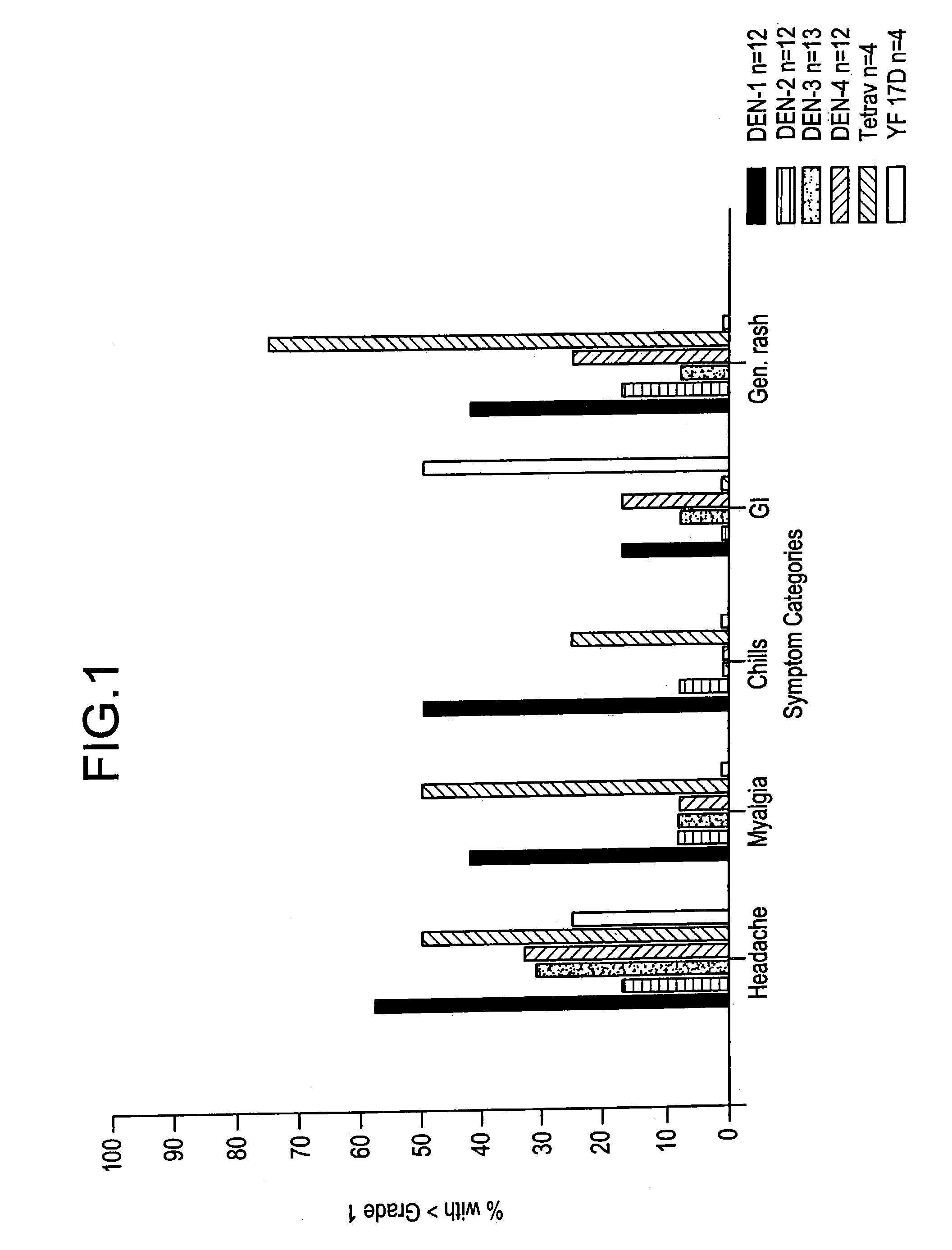Multivalent dengue virus vaccine
a dengue virus and vaccine technology, applied in the field of dengue virus vaccines, can solve the problems of inability to effectively treat acute illnesses, inability to control vectors, complex illnesses, etc., and achieve the effect of enhancing the immune response of the hos
- Summary
- Abstract
- Description
- Claims
- Application Information
AI Technical Summary
Benefits of technology
Problems solved by technology
Method used
Image
Examples
example 1
[0049]DEN virus modification in PDK cells and vaccine lot production. DEN virus strains selected for vaccine development had a variety of passage histories prior to PDK passage. In the case of DEN-4 341750 there was just one mosquito passage before inoculation of PDK cell culture, while DEN-1 West Pac 74 strain had a history of twenty FRhL cell passages prior to PDK passage (Table 1). With the exception of DEN-3, all strains adapted after a small number of PDK passages. For DEN-3, additional efforts were required to increase viral input in early passages in order to adapt this strain to PDK cells. As a general case after adaptation to PDK cells, DEN virus titers were found to be in the 104–105 PFU / ml range. Attempts to increase titers were not successful and alternative cell substrates were sought for vaccine production. DBS-FRhL-2 (FRhL) cells were selected for this purpose for several reasons: 1) DEN viruses replicate to titers of ca 106 PFU / ml allowing manufacture of DEN vaccines...
example 2
[0051]Rhesus monkeys inoculated with PDK-passaged DEN viruses. The infectivity of DEN viruses passaged in PDK cells and designated as “strain sets” was compared to parental, unmodified viruses for each serotype. Table 3 lists the results of these studies where the degree of infectivity for monkeys was measured by the number of days of viremia that could be found in sequentially drawn serum two weeks following inoculation. Parental virus inoculation of monkeys resulted in 6.8, 5, 3, and 4.7 mean days of viremia in groups of 3–4 monkeys inoculated with DEN-1, DEN-2, DEN-3, and DEN-4, respectively. For DEN-2 parent, additional data (not shown) has substantiated that infection with measurable viremia is very reproducible over time using similar monkeys and isolation techniques. Unfortunately, only partial data exists on viral titers in monkey sera. Most of the data that exists comes from experience with the DEN-2 parent virus where monkey viremic blood was titrated in mosquito cell cult...
example 3
[0072]Clinical Responses to Attenuated Dengue Vaccines
[0073]Dengue 2 S16803 Vaccine
[0074]The dengue 2 strain S16803 virus produced from the 50th passage in PDK cells was tested in three volunteers. The volunteers did well, with no oral temperatures >38.0° C. Two of 3 volunteers had transient mild symptoms of malaise, headache, and eye symptoms (eye pain or photophobia). Laboratory findings included mild ALT elevations (<2× normal) in 2 of 3, and mild leukopenia in 1 of 3 volunteers. Because of the acceptable safety profile of the PDK 50 vaccine, the next lower available passage, PDK 30, was selected for clinical evaluation.
[0075]The PDK 30 vaccine, tested in 10 subjects, was underattenuated and produced symptoms compatible with mild to moderate dengue. Four volunteers (40%) developed low grade fever, to Tmax 38.5° C., over days 9–14 post vaccination (median day 12). Eighty percent developed rash. The majority of volunteers experienced eye symptoms (10 / 10), headaches (9 / 10), and mala...
PUM
| Property | Measurement | Unit |
|---|---|---|
| volumes | aaaaa | aaaaa |
| temperature | aaaaa | aaaaa |
| temperature | aaaaa | aaaaa |
Abstract
Description
Claims
Application Information
 Login to View More
Login to View More - R&D
- Intellectual Property
- Life Sciences
- Materials
- Tech Scout
- Unparalleled Data Quality
- Higher Quality Content
- 60% Fewer Hallucinations
Browse by: Latest US Patents, China's latest patents, Technical Efficacy Thesaurus, Application Domain, Technology Topic, Popular Technical Reports.
© 2025 PatSnap. All rights reserved.Legal|Privacy policy|Modern Slavery Act Transparency Statement|Sitemap|About US| Contact US: help@patsnap.com



